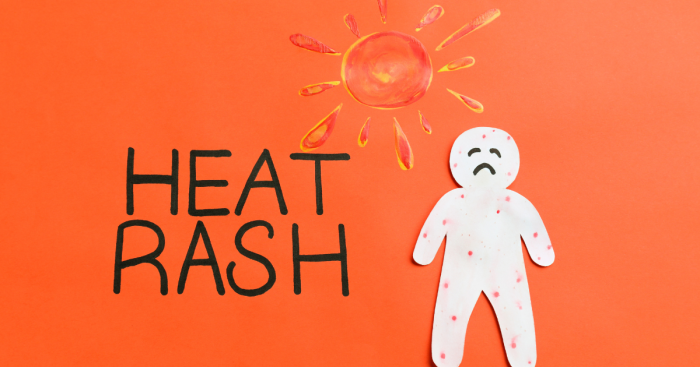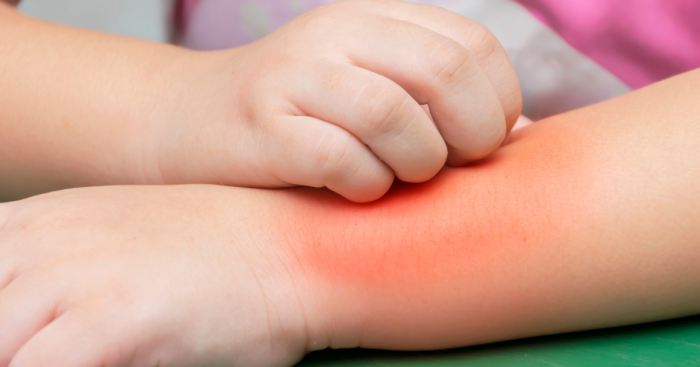Malaysian weather is well known for its unrelenting sun, heat and humidity all year round. While average daytime temperatures in the lowlands hover around 32° to 34°Celcius, it could get a lot hotter, drier and sweatier during the hot season from March through to June every year where average daily temperatures could reach 37° Celsius or even higher. With rainfall being scarcest during this period causing hot dry air all around, babies, toddlers, older children and even adults become prone to a host of skin conditions such as heat rash if steps are not taken to minimize or prevent its occurrence.
What is Heat Rash?

Like its name implies, heat rash – the itchy, pink or red blisters erupting all over the skin − is caused by heat. Also known as sweat rash, prickly heat and miliara[1], heat rash occurs when the skin’s pores or sweat ducts overwork and become blocked and inflamed[2] due to excessively high temperatures, high humidity and irritation on the skin.
The use of certain products such as ointments, creams and lotions can exacerbate heat rash as they block the sweat glands. If you notice heat rash on the child’s forehead, it could be due to using oils or oily products on the child’s hair.
Based on the level of the sweat duct obstruction, heat rash or miliaria can be divided into three types[3]:
- Miliaria Crystallina: Sweat gland obstruction close to the surface of the skin. It presents as clear blisters that easily break and leave a bran-like scale. Usually widely spread on the head, neck and upper trunk of body.
- Miliaria Rubra: Sweat gland obstruction in the middle section under the skin. It presents as small, red, inflamed blisters that are very itchy or prickle the affected area. This is why this type of heat rash is also known as prickly heat and is most common in children, especially newborn babies aged one to three weeks old because their sweat glands are less developed than older children and adults.
- Miliaria Profunda: Result of sweat leaking from the sweat glands into the deepest layer of the skin following repeated episodes of Miliaria Rubra. In fact, Miliaria Profunda is a variation of Miliaria Rubra but causes firm, painful or itchy, inflamed bumps that look like goosebumps that may break open any time.
How To Identify[4] Heat Rash in Children

- They appear as tiny pink or white bumps on the skin.
- Occurs during hot, humid weather or after playing or running around under the sun.
- Heat rash can be itchy and irritating.
- There is redness and mild swelling of the affected area.
- In babies, the rash can appear as tiny water blisters in the skin folds, face and in the nappy area.
- In toddlers and older children the rash may have a “prickly” pins-and-needles sensation and appear mainly on the neck, chest upper back and also in the nappy area if the toddler is still wearing diapers. Clothing rubbing on the skin may worsen the condition.
- There is no fever or illness occurring at the same time. If there is, it may not be heat rash but another type of rash due to an infection or allergy.
- On the other hand, a heat rash can cause an infection if the child scratches at the rash and causes the blisters to break. Broken blisters can result in an abrasion or abscess leading to bacterial infections in the skin which in turn could cause a fever and illness.
How to Treat[5] and Prevent[6] Heat Rash in Children

- Remove the child from the sun.
- Change the clothing of your child if they are wearing heavy, less breathable fabrics.
- Dress the child in single layer, loose cotton clothing.
- During outdoor activities, make sure the child is hydrated frequently.
- If you are taking your child outdoors, bring along portable fans for evaporative cooling.
- Never leave a child to sleep in a baby carrier, car seat or stroller. The padding on these seats and carriers are thick and insulating and do not allow proper airflow.
- Lower the temperature in your home with a fan or turn the air conditioner on.
- If the child is sweating a lot, wipe it off and let his body air dry.
- Wipe off any lotion, oil, cream or moisturisers as these oils could block sweat ducts.
- Avoid using excessive soap or other irritants on the skin, especially after the onset of heat rashes.
- Discourage your child from scratching the rash as it can irritate the skin further.
- Cool the skin with a cool compress or a cool bath. For small rashes, after the child has dried off from sweat and has sufficiently cooled down, place a cool, damp washcloth to act as a cool compress on the area. For large patches of rash, after the child has dried off and cooled down, give him a cool bath without soap. Let the rash area air dry.
- Use cotton bedsheets and don’t have your child sleeping under heavy blankets or quit made out of synthetic fabrics at night. Make sure his room is well ventilated.
- Avoid clothing and bedding material such as polyester or polyester blends as they tend to trap heat and sweat.
- Avoid further sweating by letting the child stay in an airconditioned room a few hours a day. It could speed up healing.
- Apply Calamine lotion on the affected parts to cool and soothe the affected parts.
Complications
The good news about heat rash is that it usually clears up on its own. However, if the rashes don’t clear up after three days of starting treatment, or if:
- The rash is spreading and turning a dark colour[7]
- The rash is warm to the touch
- If there is pus oozing from the rash
- If it bleeds and looks crusty
- If there is high fever in your child
- If there are other accompanying symptoms of illness such as a sore throat or an aching body
Then it is time to go see the doctor.
How to Know if it is Heat Rash or Something Else

Children are prone to getting all kinds of rashes. This is because children lie on the floor, play outside, often share many things such as toys and are less likely to take cleanliness precautions as much as adults. Parasitic, bacterial and fungal infections[8] can spread quickly through play gyms, playgrounds, or day care centres and in kindergarten or school.
Most rashes are harmless and will go away on their own especially if they are just a case of heat rash. However, not all rashes are heat rash although the symptoms and appearance may appear to be more or less the same.
Here’s how you can identify the different types of rashes that children often get and decide if you should take your child to a doctor for a proper diagnosis and treatment.
- Chickenpox
Chickenpox is caused by the varicella-zoster virus. It presents as itchy rashes that turn into fluid-filled blisters that look like chickpeas − hence the nickname chickenpox. Very often, the child will have fever and the blisters will pop and crust over to form scabs that eventually fall off.
- Cellulitis
Cellulitis[9] is a bacterial infection of the deeper layers of the skin and underlying tissues that usually occur after some kind of trauma that causes an opening in the child’s skin. The affected area will be red, painful, swollen and hot. Your child may also have a fever.
- Eczema
Eczema[10] is a long-term condition that causes the skin to become itchy, red, dry and cracked. The most common type is atopic eczema which mainly affects children but can continue into adulthood.
- Erythema multiforme
This is a mild skin rash that is caused by an allergic reaction to the herpes simplex virus[11]. The spots look like targets with a dark, red centre surrounded by a paler ring. Your child would likely develop a fever.
- Hand, Foot and Mouth Disease
Hand, Foot and Mouth Disease[12] is a mild but very contagious viral infection caused by the coxsackievirus. It is common in young children especially those under 10. The disease causes mouth ulcers and spots and blisters on the palms of the hands and soles of the feet accompanied by fever.
- Impetigo
Impetigo is a common and highly contagious bacterial skin infection that mainly affects infants and young children. It causes reddish sores and blisters on the face, especially around the nose, mouth and hands and feet. After about a week, the sores burst leaving a yellow-brown crust.
- Measles
Measles[13] commonly affects young children. It is caused by a virus in the paramyxovirus family and is normally passed through direct contact and the air. The disease usually begins with nasal congestion, eye redness, swelling and tearing, cough, lethargy and high fever. The child will also develop blotchy red-brown rashes on the face which rapidly spreads. Another rash consisting of white spots inside the mouth may also develop.
- Rubella
Rubella[14] is milder and is caused by the rubivirus. Symptoms of Rubella appear as a pink or red rash on the face which then spreads to the rest of the body. The child may develop swollen lymph nodes in the neck behind the ears. Rubella is more dangerous to developing foetuses. If a pregnant woman contracts it, Rubella can cause serious and permanent damage to the unborn child.
- Psoriasis
Psoriasis[15] is a lifelong chronic skin condition with no cure. The condition, often triggered by stress, illness such as strep infections, causes red, flaky, crusty patches on the skin with silvery scales but it isn’t contagious.
- Scabies
Scabies[16] is a contagious skin condition that is intensely itchy. It is caused by tiny mites that burrow into the skin. In babies and young children, scabies presents itself as small red blotches of fluid-filled bumps on the palms of the hands and soles of the feet. Sometimes, they appear on the scalp of infants.
- Scarlet Fever
Scarlet Fever[17] is a highly contagious bacterial infection that usually affects children between two and eight years of age. The illness is caused by the Streptococcus pyogenes bacteria and produces a distinctive pink-red rash which feels like sandpaper and may be itchy.
Urticaria or Hives
Urticaria is also known as hives and is a common skin reaction that affects children. The symptoms are raised clusters of itchy red rashes that can affect one part of the body or spread across large areas. The causes include: food, tight clothing, insect bites, dust, latex, mold, pets, pollen, medicines, heat or exercise or even infections such as the common cold or strep throat.




